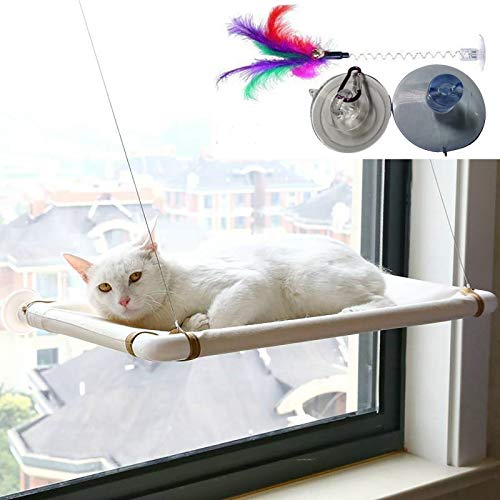Cats are naturally drawn to windows. It’s easy to see why — during the day, the sun often makes them the warmest spots in the house. Plus, what better place to watch the birds flying by and take in all the action of the outdoors?
But having your cat constantly trying to climb into and sit in a window creates some problems. My cats became all too talented in knocking my potted plants off the windowsills. One cat became determined to curl up on windowsills that were just too narrow for her, often rolling right out of them as she lounged. And then there are the scratches on the sill and the wall below from my cats’ trying to get up into this desirable spot.
The Buy at Amazon solved all that. Equipped with powerful suction cups and a durable cloth bed, this window seat mounts right onto the glass of your window. It installs in just minutes, and since I installed it, it has stayed put, even when my 15-pound kitty decides to give it a try.
This hammock seat gives your cats their own perch and window-side view. It creates a warm sleeping spot that my cats enjoy year-round. There’s no more problem with sills that are too narrow or with claw scratches up the sill and wall. And because my cats have their own designated spot, they steer clear of the windows that are holding potted plants and other objects.
But more than that, this hammock seat helps keep my indoor cats entertained. They can easily see outdoors, and the hammock gives them a clear view of the birds that congregate near the windows during the spring and summer. It’s easy to add a fleece blanket to the hammock in the winter, creating an extra-cozy spot.
There are plenty of other benefits to this hammock, too. I have a multi-cat household, and as well as my cats get along, sometimes they need a break from each other. The hammock gives each cat a little privacy in a spot that the other won’t disturb while it’s occupied. It also gives cats a chance to get up higher, satisfying that instinct they have to look down on their surroundings.
You can put this hammock to use in countless ways. It’s compact and lightweight, perfect for apartments. It’s also easy enough to install and remove so that you can move it from window to window, depending on your needs and your cats’ preferences. Position it in one window to catch the sun in the morning, then move it to another window to soak in the afternoon sun. Installing it in a window by a work desk gives your cat a way to feel like he’s still part of the action without necessarily having to drape himself over your desk and computer.
At under $30, this hammock is an affordable option that delivers excellent value. It can make your life with your cats easier, and it gives your cats a special place all their own. If you have a sunlight-loving, bird-watching, window-adoring cat, chances are this hammock will make him and you quite happy.



